Niuafoʻou (Tonga) 1995 "Singapore World Stamp Exhibition '95"
| <prev | back to index | next> |
| Issue Date | 01.09.1995 |
| ID | Michel: 289-291, Bl. 16 Scott: 181a-181b, 182 Stanley Gibbons: 233-235 Yvert et Tellier: 226-227, 14 Category: pR |
| Design | Derek Miller |
| Stamps in set | 3 |
| Value |
S45 - Iguanodon, Brachiosaurus and Rhamphorhynchid in background S60 - Triceratops and Tyrannosaurus T$2 - Plesiosaurus |
| Emission/Type | commemorative |
| Issue place | Niuafoʻou |
| Size (width x height) | stamps 80 x 30.6 mm, Souvenir-Sheet 110 x 70 mm |
| Layout | Mini-Sheet of 10 stamps, Souvenir-Sheet with 1 stamp |
| Products | FDC x2 |
| Paper | |
| Perforation | 12 x 12¼ |
| Print Technique | Offset, multicolor |
| Printed by | Walsall Security Printers of London, UK |
| Quantity | |
| Issuing Authority | Post office of the Government of Tonga |
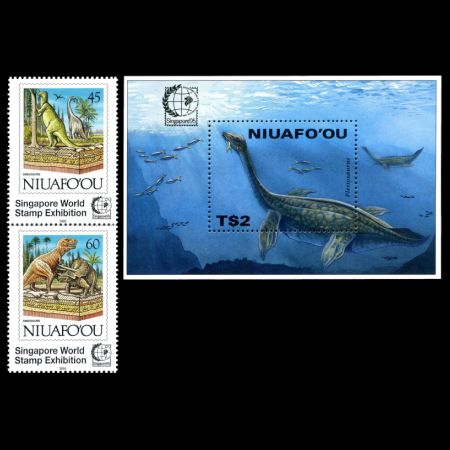
On September 1st, 1995, the Post office of the Government of Tonga on behalf of Niuafo'ou Island, issued a set of 2 stamps and a Souvenir-Sheet for the first Singapore's World Stamp Exhibition 1995, which took place from September 1 to September 10 in Singapore.
The logo and the name of the exhibition can be seen on every stamp of the set.
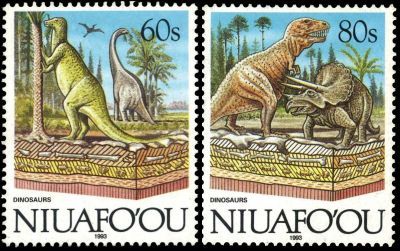 |
| Dinosaurs on stamps of Niuafo'ou 1993, MiNr.: 240-241, Scott: 117B-117C |
Two herbivorous dinosaurs, most likely Iguanodon and Brachiosaurus and pterosaur Rhamphorhynchid are shown on the first stamp.
The second stamp shows the classic scene "Fight between Triceratops and Tyrannosaurus".
Both stamps reuse the designs of two stamps from a set of four stamps, "Evolution of the Earth" (IV) from 1993, see on the right.
During the "Dinosaurs Time" the Island did not exist. Niuafo'ou is a subaerial shield volcano formed by submarine explosive and effusive activity during the Holocene. (The Holocene is the current geological Epoch, which began approximately 11,650 years before present).
Explosive volcanic activity - means the eruption of volcanic ash into the atmosphere,
which then settles out as ash deposits around the volcano.
Effusive volcanic activity - the eruption of lava that flows down the sides of the volcano,
eventually cooling to form lava flow deposits.
The Souvenir-Sheet with Plesiosaurus was specially designed for the stamps set.
Perhaps, some Plesiosaurus swam in the area where the Island exists today.
Plesiosaurus is a genus of extinct, large marine sauropterygian
reptile that lived during the Early Jurassic.
Plesiosaurus had a wide distribution in European seas and around the Pacific Ocean,
including Australia, North America, and Asia.
Plesiosaurus lends its name to the order Plesiosauria, of which it is an early, but fairly typical member.
It contains only one species, the type, Plesiosaurus dolichodeirus.
It is known from nearly complete skeletons from the Lias of England.
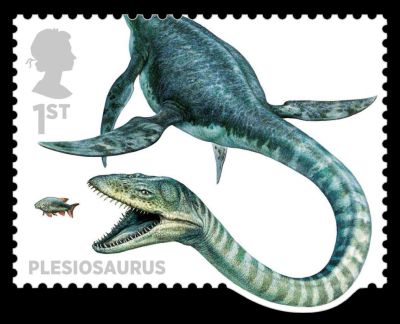 |
| Plesiosaurus on stamp of UK 2013, MiNr.: 3535, Scott: 3237 |
The first complete skeleton of Plesiosaurus was discovered by early paleontologist and fossil
hunter Mary Anning in Sinemurian (Early Jurassic)-age rocks of the lower Lias Group in December 1823.
Plesiosaurus swam by flapping its fins in the water, much as sea lions do today,
in a modified style of underwater “flight.”
The nostrils were located far back on the head near the eyes.
Plesiosaurus is distinguishable by its small head, long and slender neck, broad turtle-like body,
a short tail, and two pairs of large, elongated paddles and
were a moderately sized that grew to a length of about 3.5 meters.
These marine animals had approximately 40 neck (cervical) vertebrae, with different specimens
preserving 38 to 42 cervical vertebrae.
In early reconstructions, Plesiosaurus is shown with the neck in a swan-like pose above
the sea surface; providing an extended reach or a swift strike at prey; or allowing breathing whilst
the animal lay concealed at depth.
According to more recent research, based on the anatomy of the articular faces of contiguous cervical
vertebral centra, neural arches, and cervical ribs, the plesiosaur neck was mainly adapted for ventral
bending, with dorsal, lateral and rotational movements all relatively restricted.
Plesiosaurus may have fed by swinging its head from side to
side through schools of fish, capturing prey by using the long sharp teeth present in the jaws.
The neck of the animal was adapted for use beneath the body, suggesting feeding in the water column,
close to the sea floor, or within soft sediments on the sea floor.
Numerous features of plesiosaurs, including cranial and dental form, cervical vertebral morphology,
body shape and limb-based propulsion, conform to this model.
Products and associated philatelic items
| Plate Proof [2] | Monochrome Proof [3] | Mini-Sheet |
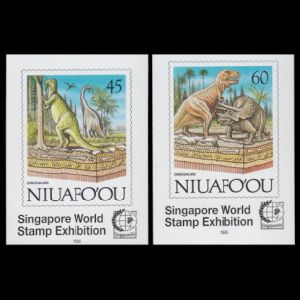 |
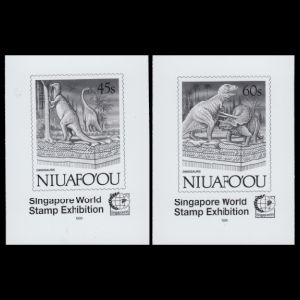 |
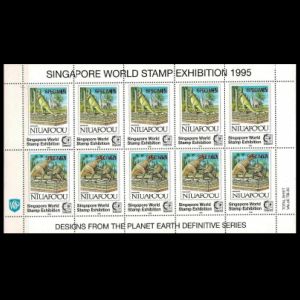 |
| FDC | Artwork (scan of another copy is here) | |
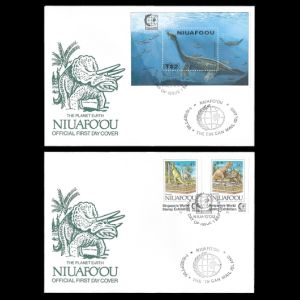 |
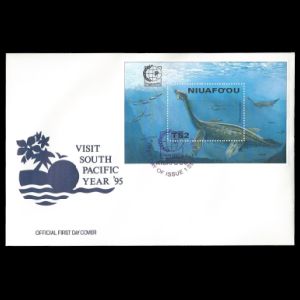 |
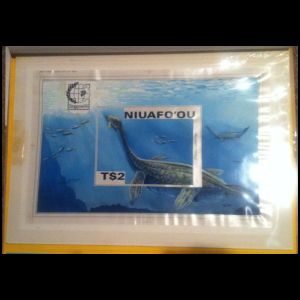 |
| Proof | ||
| Cromalin Proof - Error [1] | Cromalin Proof - Corrected [1] | Plate Proof [2] |
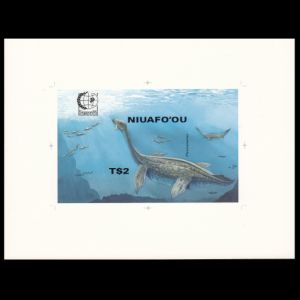 |
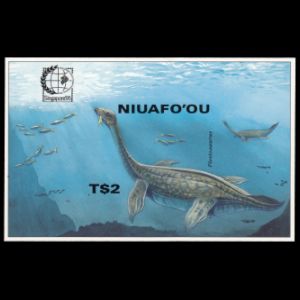 |
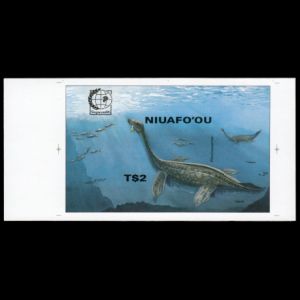 |
| Specimen [3] | Example of circulated cover | |
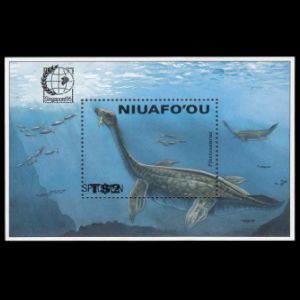 |
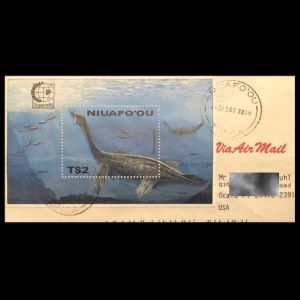 |
|
Notes:
[1] The first cromalin proof, issued in 1 copy only, did not have lines around the border of the Souvenir-Sheet - without the lines around the four sides, the top left corner blended into the margins of the Souvenir-Sheet, so after checking the first cromalin proofing, the officials decided that to avoid this problem, Walsall Security Printers should draw in border lines around the four sides, then a second corrected cromalin proofing was done showing the border lines which is the cromalin proof shown in this image.
The Cromalin Proofs are on thick cardboard and in full colour, a proofing method used by Walsall Security Printers in which full color proofs are produced directly from the color separations prior to final production of the printing plates. Each color is layered on top of the next thus building up to the full color design. As only 3 or 4 were done, cromalin proofs are quite scarce and have been in the archival material until now. These proofs are lovely looking, very high quality, with a glazed finish. And as only 3 or 4 were done, cromalin proofs are the scarcest of all proofing methods done by Walsall Security Printers for Tonga.
[2] The Plate Proofs printed one sheet of plate proofs first, this sheet was taken for checking and approval by Walsall Security Printers company and the officials of Tonga.
After it passed the necessary checks, this imperforated proof sheet was placed in the printers archives and was left imperforated. All other sheets issued were perforated.
The Tongan plate proofs are genuine proofs done by the printers for checking purposes then kept until recently in the printers' archives.
[3] The "SPECIMEN" overprint text in black was the normal specimen overprint done for most sets from 1981 to 1997. In most of the cases, Niuafo’ou's stamps were printed in sheets of 20. The printers overprinted 10-20 sheets of stamps with the word “specimen”.
About half these were sent onto the Philatelic Bureau in Nukualofa (the capital of Tonga) to give to large new issue buyers, and the Combined Philatelic Agency (CPA), who represented Tonga kingdom (including Niuafo’ou Island), kept about half the specimens to sell themselves.
[4] Tonga did not issue any imperforate stamps from this set, the only imperforates known are genuine plate proofs, and come from the Walsall Security Printers archives.

|
References
- Technical details and stamps presentation:
colnect- Stamp designer: Derek Miller
-
Plesiosaurus:
Wikipedia, Encyclopedia Britannica.
"An integrated approach to understanding the role of the long neck in plesiosaurs", by LESLIE F. NOÈ, MICHAEL A. TAYLOR, and MARCELA GÓMEZ-PÉREZ. (https://doi.org/10.4202/app.00334.2016)
Acknowledgements
- Many thanks to fellow collector Dr. Jon Noad from Canada, for sharing a scan of the Artwork from his collection.
- Many thanks to Mr. Greg Jorgensen from Australia, who sells philatelic materials from the archive of Walsall Security Printers on the Internet under the moniker tonga2, for explanations about their printing process.
- Many thanks to Dr. Peter Voice from Department of Geological and Environmental Sciences, Western Michigan University, for reviewing the draft page and his very valuable comments.
| <prev | back to index | next> |